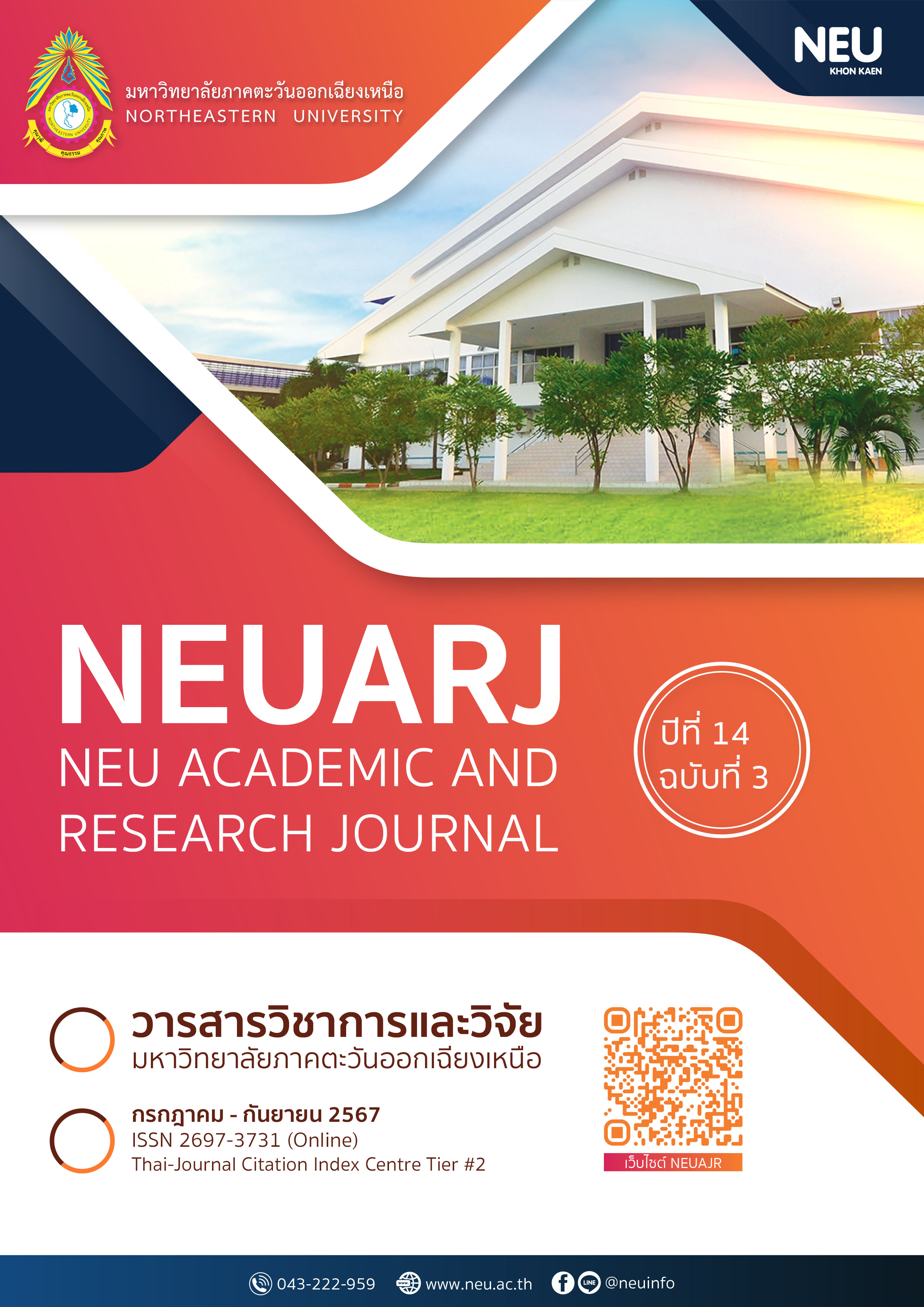การศึกษาความสามารถและปัจจัยที่เกี่ยวข้องกับความคิดสร้างสรรค์ของนักเรียน ในศตวรรษที่ 21: กรณีศึกษา นักเรียนชั้นประถมศึกษาปีที่ 2 โรงเรียนในเขตดินแดง กรุงเทพมหานคร
คำสำคัญ:
ความคิดสร้างสรรค์, ปัจจัยที่เกี่ยวข้องกับความคิดสร้างสรรค์, การประเมินความสามารถ, นักเรียนชั้นประถมศึกษาบทคัดย่อ
การวิจัยนี้มีวัตถุประสงค์เพื่อ 1) ศึกษาความสามารถในการคิดสร้างสรรค์ของนักเรียนชั้นประถมศึกษาปีที่ 2 โรงเรียนในเขตดินแดง กรุงเทพมหานคร 2) ศึกษาปัจจัยที่ส่งเสริมและเป็นอุปสรรคของความคิดสร้างสรรค์ของนักเรียนชั้นประถมศึกษาปีที่ 2 โรงเรียนในเขตดินแดง กรุงเทพมหานคร เป็นการวิจัยแบบผสานวิธีวิจัย รูปแบบวิธีการแบบขั้นตอนเชิงอธิบาย เป็นการวิจัย 2 ขั้นตอน คือ 1) การวิจัยเชิงปริมาณ คัดเลือกประชากรจากนักเรียนชั้นประถมศึกษาปีที่ 2 จำนวน 104 คน ทำแบบประเมินความสามารถในการคิดสร้างสรรค์ 2) การวิจัยเชิงคุณภาพ คัดเลือกนักเรียนชั้นประถมศึกษาปีที่ 2/1 ที่มีผลการประเมินสูงที่สุดและมีผลการประเมินน้อยที่สุด จำนวน 6 คน บันทึกการสัมภาษณ์ปัจจัยที่เกี่ยวข้องกับความคิดสร้างสรรค์ และสังเกตคุณลักษณะที่เกี่ยวข้องกับความคิดสร้างสรรค์เพื่อเก็บข้อมูล
ผลการวิจัยพบว่า 1) นักเรียนมีความสามารถในการคิดสร้างสรรค์เฉลี่ย ร้อยละ 69.6 2) ปัจจัยที่ส่งเสริมความคิดสร้างสรรค์ คือ การได้ฝึกฝนทางความคิด การได้รับการยอมรับ สนับสนุนทางความคิดอย่างเหมาะสม ปฏิสัมพันธ์ที่ดี และทักษะในการประยุกต์ใช้ความรู้ ปัจจัยที่เป็นอุปสรรคของความคิดสร้างสรรค์ คือ การถูกจำกัดการเรียนรู้ การขาดการฝึกฝนทางความคิด การขาดทักษะการคิด การขาดปฏิสัมพันธ์ การขาดทักษะในการประยุกต์ใช้ความรู้ การขาดทักษะการสื่อสาร
เอกสารอ้างอิง
กระทรวงศึกษาธิการ สำนักงานเลขาธิการสภาการศึกษา. (2562). เข้าใจสมรรถนะง่าย ๆ ฉบับประชาชน เข้าใจหลักสูตรฐานสมรรถนะอย่างง่าย ๆ ฉบับครู ผู้บริหาร และบุคลากรทางการศึกษา. บริษัท 21 เซ็นจูรี่ จำกัด.
จรัสพร บัวเรือง. (2562). การพัฒนาความคิดสร้างสรรค์โดยการเรียนรู้แบบนำตนเอง วิชาคอมพิวเตอร์ของนักเรียนชั้นมัธยมศึกษาปีที่ 2. [วิทยานิพนธ์ปริญญาศึกษาศาสตรมหาบัณฑิต, มหาวิทยาลัยธุรกิจบัณฑิตย์]. https://libdoc.dpu.ac.th/thesis/Jarasporn.Bua.pdf
จิตตินัท์ เดชะคุปต์. (2561). จิตวิทยาและวิทยาการเรียนรู้ (พิมพ์ครั้งที่ 4). โรงพิมพ์มหาวิทยาลัยสุโขทัยธรรมาธิราช.
ชลธิชา ชิวปรีชา. (2551). ความคิดสร้างสรรค์ของเด็กปฐมวัยที่ทำกิจกรรมศิลปะด้วยใบตอง. [วิทยานิพนธ์ปริญญาการศึกษามหาบัณฑิต, มหาวิทยาลัยศรีนครินทรวิโรฒ] . https://ejournals.swu.ac.th/index.php/jedu/article/view/6722/6334
ชุติมา วงษ์พระลับ. (2010). ความคิดสร้างสรรค์ที่สรรค์สร้างได้. วารสารศึกษาศาสตร์ มหาวิทยาลัยขอนแก่น, 33(4), 10 – 21.
เดอะ แมทเทอร์ ทีม. (2560, 18 กรกฎาคม). มัวแต่กลัวก็ไม่ได้เกิด ถึงเวลาบอกลาความกลัวสู่การสร้างสรรค์. https://thematter.co/social/dont-afraid-do-creative/29935
นพร อึ้งภาภรณ์. (2554). เอกสารคำสอน 6145300 วิชา การเจริญเติบโตและพัฒนาการของมนุษย์ (Growth and Development of Human). สำนักวิชาแพทยศาสตร์ มหาวิทยาลัยเทคโนโลยีสุรนารี.
ประสิทธิรักษ์ เจริญผล. (2547). ความคิดสร้างสรรค์ของเด็กปฐมวัยที่ได้รับการจัดกิจกรรมศิลปะสร้างสรรค์ต่อเติมด้วยลายเส้น. [วิทยานิพนธ์ปริญญาการศึกษามหาบัณฑิต, มหาวิทยาลัยศรีนครินทรวิโรฒ]. http://thesis.swu.ac.th/swuthesis/Ear_Chi_Ed/Prasittirak_C.pdf
พยอม ศรีสมัย. (2551). ความสัมพันธ์ระหว่างความคิดวิจารณญาณ ความคิดสร้างสรรค์และความสามารถในการใช้กระบวนทางวิทยาศาสตร์ในการแก้ปัญหาของนักเรียนชั้นมัธยมศึกษาปีที่ 3. [วิทยานิพนธ์ปริญญาศึกษาศาสตรมหาบัณฑิต, มหาวิทยาลัยสงขลานครินทร์]. https://kb.psu.ac.th/psukb/handle/2010/6710
สมพร หลิมเจริญ. (2552). การพัฒนาหลักสูตรเสริมเพื่อส่งเสริมความคิดสร้างสรรค์ สำหรับนักเรียนช่วงชั้นที่ 2. [วิทยานิพนธ์ปริญญาดุษฎีบัณฑิต, มหาวิทยาลัยศรีนครินทรวิโรฒ]. http://thesis.swu.ac.th/swudis/Cur_Re_Dev/Somporn_L.pdf
Abid, H., Mohd, J., Mohd A.Q. and Rajiv S. (2022). Understanding The Role of Digital Technologies in Education: A Review. Sustainable Operations and Computers, 3, 275–285.
Aljumyd, M., Zuri, M. and Zaharudin, R. (2015). The Development of Creativity across the Different Stages of Growth. Elixir Soc. Sci., 81, 31740 – 31744.
Cátia, G. and Orlando L.R. (2021). Learning Creativity and Student’s Performance: An Empirical Study from Portugal. CEI–ISCAP Intercultural Studies E-Journal, (9), 1 – 16.
CNLD Testing & Therapy. (2023). How Long Should a Child’s Attention Span Be?. https://www.cnld.org/how-long-should-a-childs-attention-span-be/.
Dorfman, L. and Gassimova, V. (2017). A Variation Account of Divergent Thinking. Journal of Literature and Art Studies, 7(8), 1039 – 1053. DOI: 10.17265/2159-5836/2017.08.013.
Dorota – Maria, J. & Jacek, G. (2022). The Familial Context of Children’s Creativity Parenting Style and The Climate for Creativity in Parent – Child Relationship. Creativity studies, 14(1), 1 – 24.
Eppy, S., Umi, H. and Mujadidienm, A. (2019). The correlation between parenting style and child creativity development. Journal of Public Health in Africa, 10(1s), 134 – 136. DOI: 10.4081/jphia.2019.1207.
Jonathan M.C. and Sherin S.S. (1986). Shyness and verbal creativity. Journal of Research in Personality, 20(1), 51-61. DOI: 10.1016/0092-6566(86)90108-X.
Judith, B.P. (1984). Guilford’s Structure of Intellect Theory: An Evaluation of the Three Dimensional Model and the Implication for Its Use in the Education of the Gifted Child. (Master Degree of Arts Thesis). Western Kentucky University, Faculty of the Department of Psychology. https://digitalcommons.wku.edu/cgi/viewcontent.cgi?article=2813&context=theses
Kardefelt – Winther, D. (2017). How Does the Time Children Spend Using Digital Technology?Impact Their Mental Well-being, Social Relationships and Physical Activity? An Evidence-focused Literature Review. Innocenti Discussion Paper 2017-02. [Article]. UNICEF Office of Research – Innocenti, Florence.
Koestner, R., Ryan, R.M, Bernieri, F.J. and Holt, K.D., (2010). Setting Limits on Children’s Behavior: The differential effects of controlling versus informational styles on Intrinsic Motivation and Creativity. Journal of Personality, 52(3), 233-248.
Lilly F.R. Creativity in Early Childhood. Edited by Gullotta T.P. and Bloom M. (2014). Encyclopedia of Primary Prevention and Health Promotion. Springer, Boston, MA. (2014) DOI: 10.1007/978-1-4614-5999-6_160.
Marina B. and Gert W. (2020). Schinkel, Anders (ed.) (2020). Wonder, Education, and Human Flourishing. VU University Press.
Moisés, S.S., Manoli, P., Andreea, C., Laia, C., and Enric, F., (2022). The Role of Digital Technologies to Promote Collaborative Creativity in Language Education. Front. Psychol, (13) https://doi.org/10.3389/fpsyg.2022.828981.
Nikolopoulou, K. (2018). Research on e – Learning and ICT in Education. (Mikropoulos, T.A.Ed.). Springer.
Olger, G.A., Bertha C.H., Maximo P.C., Vanessa A.D., David R., and Sandra C.H. (2021). Influencing Factors in Creativity in Learning, Mediated by Self – Confidence in University Students in The Post – Pandemic. IV International Congress of Trends in Educational Innovation CITIE 2022. Arequipa, Perú.
O’Neill, B. (2023). Research for CULT Committee – The Influence of Social Media on The Development of Children and Young People, European Parliament. Policy Department for Structural and Cohesion Policies, Brussels.
Saima, S., (2020). Parent – Child Interaction in Relation to Creative Ability of Secondary School Students. American Journal of Education and Learning, 5(1), 42 – 49. DOI:10.20448/804.5.1.42.49.
Seyed A.M., Sara R. and Mahdieh T. (2015). The Relationship between Parenting Styles and Creativity and the Predictability of Creativity by Parenting Styles. Procedia - Social and Behavioral Sciences, 205, 56 – 60.
Shahzad, A. (2006). What is Globalization - Historical Background. Jadavpur Journal of International Relations, 10(1), 204 – 212.
Tehrani, N.R. (2015). Effective factors on Nurturing the Creativity of Children and Teenagers. Research Journal of Fisheries and Hydrobiology, 10(9), 653 – 660.

ดาวน์โหลด
เผยแพร่แล้ว
รูปแบบการอ้างอิง
ฉบับ
ประเภทบทความ
สัญญาอนุญาต
ลิขสิทธิ์ (c) 2024 วารสารวิชาการและวิจัย มหาวิทยาลัยภาคตะวันออกเฉียงเหนือ

อนุญาตภายใต้เงื่อนไข Creative Commons Attribution-NonCommercial-NoDerivatives 4.0 International License.


